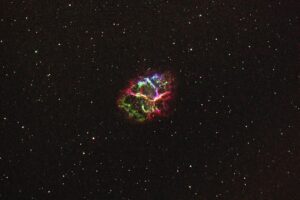The Galactic Halo is a vast, spherical region surrounding the disk of a galaxy, encompassing its outermost stars, globular clusters, and dark matter. This halo is not easily visible to the naked eye, as it contains a sparse distribution of stars and is often obscured by the bright light of the galactic core. The Milky Way, for instance, is surrounded by a halo that extends far beyond the visible components of the galaxy, reaching out to distances of hundreds of thousands of light-years.
The halo plays a crucial role in the overall structure and dynamics of galaxies, influencing their formation and evolution over cosmic time. Within this halo, one can find a mix of ancient stars and stellar remnants, which are remnants of the early universe. These stars are typically older than those found in the galactic disk and provide valuable insights into the history of star formation and chemical enrichment in the galaxy.
The Galactic Halo is also home to dark matter, an elusive substance that does not emit light or energy, making it difficult to detect directly. However, its presence is inferred through gravitational effects on visible matter, radiation, and the large-scale structure of the universe. Understanding the Galactic Halo is essential for comprehending not only our own galaxy but also the broader context of galaxy formation and evolution across the cosmos.
Key Takeaways
- The Galactic Halo is a vast, spherical region surrounding the Milky Way galaxy, composed of old stars, globular clusters, and dark matter.
- Scientists study the Galactic Halo through observations of its stars, globular clusters, and the motions of these objects, as well as through simulations and modeling.
- The Galactic Halo plays a crucial role in the evolution of the Milky Way galaxy, influencing the formation and distribution of stars and the overall structure of the galaxy.
- The origins of the Galactic Halo are still not fully understood, but it is believed to have formed from the merging of smaller galaxies and the accretion of intergalactic gas.
- Dark matter in the Galactic Halo remains a mystery, with its nature and distribution being a key focus of research in understanding the structure and evolution of galaxies.
The Composition of the Galactic Halo
The composition of the Galactic Halo is diverse and complex, primarily consisting of old stars, globular clusters, and dark matter. The old stars found in the halo are typically metal-poor, indicating that they formed in the early stages of the universe when heavy elements were scarce. These stars are often red giants or horizontal branch stars, which have evolved past their main-sequence phase.
Their distribution within the halo is not uniform; instead, they tend to cluster around certain regions, providing clues about the history of star formation and accretion events that have shaped the galaxy. Globular clusters are another significant component of the Galactic Halo. These tightly bound groups of stars can contain thousands to millions of stars and are thought to be remnants of the early universe.
They orbit the galactic center in highly elliptical paths and can be found at various distances from the galactic core. The study of these clusters offers insights into the conditions of star formation in the early universe and helps astronomers understand how galaxies like the Milky Way have evolved over billions of years. Additionally, dark matter constitutes a substantial portion of the halo’s mass, although its exact nature remains one of the most profound mysteries in astrophysics.
How Do Scientists Study the Galactic Halo?

Studying the Galactic Halo presents unique challenges due to its diffuse nature and the presence of dark matter. Astronomers employ a variety of techniques to investigate this region, including photometric surveys, spectroscopic observations, and simulations. One common method involves using large telescopes equipped with advanced imaging technology to capture light from distant stars within the halo.
By analyzing their brightness and color, scientists can infer their distances and ages, providing a clearer picture of the halo’s stellar population. Spectroscopy plays a crucial role in understanding the chemical composition and motion of stars in the Galactic Halo. By examining the light spectra emitted by these stars, researchers can determine their metallicity and radial velocities. This information helps astronomers trace the kinematics of halo stars and understand their orbits around the galactic center.
Additionally, simulations based on cosmological models allow scientists to predict how dark matter interacts with visible matter in the halo, offering insights into its distribution and effects on galactic dynamics. These combined approaches enable researchers to piece together a comprehensive understanding of the Galactic Halo’s structure and evolution.
The Role of the Galactic Halo in Galactic Evolution
| Metrics | Data |
|---|---|
| Stellar Populations | Old, metal-poor stars |
| Chemical Enrichment | Low metallicity, high alpha-element abundance |
| Formation History | Accretion of smaller galaxies, in-situ formation |
| Role in Galactic Evolution | Contributing to the overall chemical and dynamical evolution of the galaxy |
The Galactic Halo plays a pivotal role in shaping a galaxy’s evolution over time. It serves as a reservoir for primordial gas and dark matter that can influence star formation rates within the galactic disk. As galaxies interact with their surroundings—through mergers or accretion events—the material from the halo can be funneled into the disk, triggering new episodes of star formation.
This process is particularly evident in galaxies that have experienced significant mergers with smaller satellite galaxies, which can deposit gas and stars into the disk. Moreover, studying the halo provides insights into how galaxies evolve through interactions with their environment. For instance, when two galaxies collide, their halos can merge, leading to complex gravitational interactions that reshape both galaxies’ structures.
The resulting starburst activity can lead to an increase in star formation rates within both galaxies involved in the merger. Understanding these processes is crucial for constructing models that explain how galaxies like our Milky Way have transformed over billions of years.
The Origins of the Galactic Halo
The origins of the Galactic Halo are deeply intertwined with the history of our universe itself. It is believed that halos formed during the early stages of cosmic evolution when matter began to clump together under gravity’s influence. As gas cooled and condensed, it led to the formation of stars and clusters that eventually populated these halos.
The first stars formed in these regions were likely massive and short-lived, contributing to early chemical enrichment through supernova explosions. Over time, as galaxies formed and evolved, interactions between them contributed to the growth and complexity of their halos. Accretion events—where smaller galaxies merge with larger ones—have played a significant role in shaping halos by adding new stars and dark matter.
This process has been ongoing since the early universe, leading to a rich tapestry of stellar populations within halos that reflect their dynamic histories. Understanding these origins helps astronomers piece together not only our galaxy’s past but also that of countless others throughout cosmic history.
The Mysteries of Dark Matter in the Galactic Halo

Dark matter remains one of the most enigmatic components of modern astrophysics, particularly within the context of the Galactic Halo. Although it cannot be observed directly due to its non-interaction with electromagnetic forces, its presence is inferred through gravitational effects on visible matter. In fact, studies suggest that dark matter constitutes approximately 85% of all matter in the universe, with a significant portion residing within galactic halos.
The distribution and behavior of dark matter within halos are critical for understanding galaxy formation and evolution. Observations indicate that dark matter forms a “halo” around galaxies, influencing their rotation curves—how fast stars orbit around a galaxy’s center.
Researchers utilize simulations to model dark matter’s behavior under various conditions, helping to refine our understanding of its properties and interactions.
The Galactic Halo and the Search for Extraterrestrial Life
The Galactic Halo may also hold implications for astrobiology and our search for extraterrestrial life. While most searches for life focus on planets within habitable zones around stars in galactic disks, understanding halo dynamics can provide context for how life-supporting materials might be distributed throughout a galaxy. For instance, if ancient stars in halos contain planets or remnants that could harbor life or prebiotic chemistry, they may offer clues about life’s potential origins beyond our solar system.
The study of globular clusters within halos may also yield insights into environments where life could exist or have existed in different forms throughout cosmic history.
The Future of Research on the Galactic Halo
As technology advances and new observational techniques emerge, research on the Galactic Halo is poised for significant breakthroughs in understanding its complexities. Upcoming telescopes like NASA’s James Webb Space Telescope (JWST) will provide unprecedented views into distant regions of space, allowing astronomers to probe deeper into halo structures and their stellar populations than ever before. These observations will enhance our knowledge about star formation processes and chemical evolution within halos.
Moreover, advancements in computational astrophysics will enable more sophisticated simulations that incorporate dark matter dynamics alongside baryonic physics—essentially how normal matter interacts with gravity and other forces. This holistic approach will help refine our models for galaxy formation and evolution while addressing lingering questions about dark matter’s nature and behavior within halos. In summary, ongoing research into the Galactic Halo promises to deepen our understanding not only of our own Milky Way but also of galaxies across the universe.
As we continue to unravel its mysteries, we may uncover fundamental truths about cosmic evolution and our place within it.
The concept of the Galactic Halo is a fascinating topic in astrophysics, often involving discussions about the distribution of dark matter and the dynamics of stars in the outer regions of galaxies. While this topic is primarily scientific, it can also intersect with philosophical inquiries about the nature of knowledge and understanding. For those interested in exploring how philosophical perspectives can enrich our understanding of scientific concepts like the Galactic Halo, you might find the article on Russell’s Philosophy of Language and Knowledge particularly insightful. This article delves into how language and knowledge are constructed, which can provide a unique lens through which to view complex scientific phenomena.





















+ There are no comments
Add yours